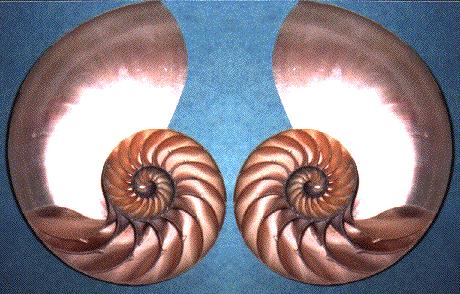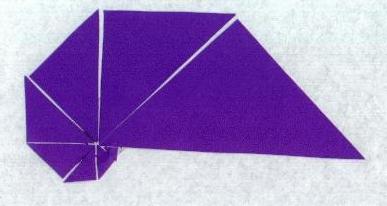Chambered Nautilus
 Introduction
IntroductionThe shell of the nautilus looks similar to the shells of some snails, but the nautilus is a relative of squids and octopuses. Its shell is divided into chambers, and the animal always lives in the biggest chamber in the front. But the other chambers are also important because the nautilus uses them to control its buoyancy, and it either hovers close to the surface or goes deep down toward the bottom of the ocean. Activity Students will create sets of similar triangles which, fixed together with a piece of Scotch tape, form a spiral-like, segmented shape, slightly similar to the cross section of the shell of a nautilus. Calculations: simple scientific calculator (for example TI-30Xa) Part I. Basic Procedure [ top ] 1. Take a right triangle and cut it along its height into two similar right triangles. Keep the smaller triangle. Take the bigger triangle and repeat this procedure. 2. The longer leg of one of these triangles is equal to the hypotenuse of the next one, so if they are joined together in a way that the smallest angles of both triangles are adjecent, the configuration starts forming a "spiral". 3. To keep the triangle pieces together, it is usually enough to have one small square of Scotch tape (0.5 X 0.5 inches) in the center. 4. In order for the spiral to close nicely, 360 degrees must be a whole multiple of the smallest angle B of the triangle (see diagram). Thus B = 360/n for some whole number n. The smaller (or smaller or equal) of two acute angles of a right triangle has at most 45 degrees; so therefore n must be at least 8 since 360 degrees/8 = 45 degrees. You cannot make a chambered nautilus with less than 8 triangles. For a given n, the basic procedure is repeated n times, yielding n usable triangles and one small "tail" triangle to be discarded.
1. Students should work in pairs. Each pair needs one colored 5 X 8 inch index card, rulers, pencils, a simple scientific calculator (for example TI-30Xa), two pairs of scissors, and either triangles or other index cards to help make right angles. A protractor is optional, but it is not really needed. 2. Each pair will make two nautiluses, each having n chambers. The value of n should be between 8 and 15 (inclusively), and it is either chosen by the students or assigned by the teacher to each pair.
Therefore, if 8 * tan(B) < 5, then
(1) a = 8 inches and b = 8 * tan(B) inches; otherwise, if 8 * tan(B) > 5, then
(2) a = 5 / tan(B) inches and b = 5 inches You may check that for n less than or equal to 11, case (2) is true; and for n greater than or equal to 12, case (1) is true. 4. Procedure:
6. Using a triangle of another index card, draw all the necessary llines on your triangle. You should see n+1 similar triangles; the last one is to be discarded. 7. Cut along the drawn lines and form a spiral. Fix it in the center with a square of Scotch tape. Precision in your work is very important! 
Nautiluses look great when they are displayed on a window so the sunlight comes through the edges of the triangles. Part III. For Teachers Only [ top ] The following table is for use by the teacher and should not be given to the students.
This table tells us that for angles such that n greater than or equal to 12, we can make a right triangle with longer leg equal to 8 inches. For angles where n = 8, 9, 10, or 11, we can make a right triangle with shorter leg equal to 5 inches. |

